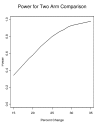A cluster randomized controlled trial comparing three methods of disseminating practice guidelines for children with croup [ISRCTN73394937]
- PMID: 16722541
- PMCID: PMC1471799
- DOI: 10.1186/1748-5908-1-10
A cluster randomized controlled trial comparing three methods of disseminating practice guidelines for children with croup [ISRCTN73394937]
Abstract
Background: The optimal management of croup--a common respiratory illness in young children--is well established. In particular, treatment with corticosteroids has been shown to significantly reduce the rate and duration of intubation, hospitalization, and return to care for on-going croup symptoms. Furthermore treatment with a single dose of corticosteroids does not appear to result in any significant adverse outcomes, and yields overall cost-savings for both families and the health care system. However, as has been shown with many other diseases, there is a significant gap between what we know and what we do. The overall aim of this study is to identify, from a societal perspective, the costs and associated benefits of three strategies for implementing a practice guideline that addresses the management of croup.
Methods/designs: We propose to use a matched pair cluster trial in 24 Alberta hospitals randomized into three intervention groups. We will use mixed methods to assess outcomes including linkage and analysis of administrative databases obtained from Alberta Health and Wellness, retrospective medical chart audit, and prospective telephone surveys of the parents of children diagnosed to have croup. The intervention strategies to be compared will be mailing of printed educational materials (low intensity intervention), mailing plus a combination of interactive educational meetings, educational outreach visits, and reminders (intermediate intensity intervention), and a combination of mailing, interactive sessions, outreach visits, reminders plus identification of local opinion leaders and establishment of local consensus processes (high intensity intervention). The primary objective is to determine which of the three intervention strategies are most effective at lowering the rate of hospital days per 1,000 disease episodes. Secondary objectives are to determine which of the three dissemination strategies are most effective at increasing the use of therapies of known benefit. An economic analysis will be conducted to determine which of the three intervention strategies will most effectively reduce total societal costs including all health care costs, costs borne by the family, and costs stemming from the strategies for disseminating guidelines.
Figures
References
-
- Grimshaw J, Shirran L, Thomas R, Mowatt G, Fraser C, Bero L, Grilli R, Harvey E, Oxman A, O'Brien MA. Changing provider behavior: an overview of systematic reviews of interventions. Med Care. 2001;39:2–II. - PubMed
-
- Kairys S, Olmstead EM, O'Connor GT. Steroid treatment of laryngotracheitis: a meta-analysis of the evidence from randomized trials. Pediatrics. 1989;83:683–693. - PubMed
LinkOut - more resources
Full Text Sources
Molecular Biology Databases
Miscellaneous


